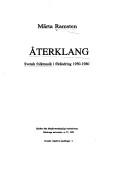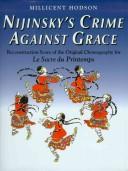| Listing 1 - 10 of 53 | << page >> |
Sort by
|

ISBN: 3921029074 Year: 1972 Publisher: Hamburg Karl Dieter
Abstract | Keywords | Export | Availability | Bookmark
 Loading...
Loading...Choose an application
- Reference Manager
- EndNote
- RefWorks (Direct export to RefWorks)
Folk music --- History and criticism. --- Ethnic music --- Traditional music --- History and criticism --- Folklore --- Music
Book
ISBN: 981164473X 9811644721 Year: 2021 Publisher: Singapore : Springer,
Abstract | Keywords | Export | Availability | Bookmark
 Loading...
Loading...Choose an application
- Reference Manager
- EndNote
- RefWorks (Direct export to RefWorks)
Folk music --- History and criticism. --- Ethnic music --- Traditional music --- Folklore --- Music

ISBN: 9185974196 Year: 1992 Publisher: Göteborg Göteborgs Universitet. Musikvetenskapliga institutionen
Abstract | Keywords | Export | Availability | Bookmark
 Loading...
Loading...Choose an application
- Reference Manager
- EndNote
- RefWorks (Direct export to RefWorks)
Folk music --- -Ethnic music --- Traditional music --- Folklore --- Music --- History and criticism --- History and criticism. --- -History and criticism

ISBN: 0945193777 157647335X Year: 1996 Publisher: Stuyvesant Pendragon Press
Abstract | Keywords | Export | Availability | Bookmark
 Loading...
Loading...Choose an application
- Reference Manager
- EndNote
- RefWorks (Direct export to RefWorks)
The music and dance of the Tokelau Islands was affected by the wave of modernization which swept the Pacific following the establishment of the Western powers in the 19th Century. Although remote and isolated these tiny islands were fully involved in the recreation of their traditional music and dance style to reflect the new ideologies and technology. Yet the new form also maintains a strong sense of local identity and the ebullience and vigor of Polynesian dance, music, drumming, singing and text composition. In this study the work of local composers and the social context of performance are acknowledged, the separate elements of music, dance and poetic text are considered as they are interrelated within this form, and the history and geographical spread of the fatele to other islands. Working in the islands and in New Zealand (where the majority of Tokelauans now live) Allan Thomas also charts his growing understanding of the dance and music through more than ten years of fieldwork showing the special features that this modern form presents within studies of traditional musics.
78.37 --- Fātele (Dance) --- Folk music, Tokelauan. --- Folk dancing, Tokelauan --- Folk music --- Ethnic music --- Traditional music --- Folklore --- Music
Periodical
ISSN: 18920772 27037320
Abstract | Keywords | Export | Availability | Bookmark
 Loading...
Loading...Choose an application
- Reference Manager
- EndNote
- RefWorks (Direct export to RefWorks)
folk music --- traditional music --- traditional dance --- scandiavian traditional music --- musicology --- Folk music --- Folk music. --- Scandinavia. --- Norway. --- Ethnic music --- Traditional music --- Folklore --- Music --- Fennoscandia --- Norden --- Nordic countries --- Kingdom of Norway --- Kongeriket Noreg --- Kongeriket Norge --- Noreg --- Norga --- Norge --- Norgga gonagasriika --- Norja --- Noruw --- Norvège --- Norvegia --- Norveška --- Norwegen --- Norwegia
Book
ISBN: 9780691162089 0691162085 9780691143637 0691143633 9786612692185 140083516X 1282692186 9781400835164 9781282692183 6612692189 Year: 2010 Publisher: Princeton, NJ
Abstract | Keywords | Export | Availability | Bookmark
 Loading...
Loading...Choose an application
- Reference Manager
- EndNote
- RefWorks (Direct export to RefWorks)
Music, and folk music in particular, is often embraced as a form of political expression, a vehicle for bridging or reinforcing social boundaries, and a valuable tool for movements reconfiguring the social landscape. Reds, Whites, and Blues examines the political force of folk music, not through the meaning of its lyrics, but through the concrete social activities that make up movements. Drawing from rich archival material, William Roy shows that the People's Songs movement of the 1930's and 40's, and the Civil Rights Movement of the 1950's and 60's implemented folk music's social relationships--specifically between those who sang and those who listened--in different ways, achieving different outcomes. Roy explores how the People's Songsters envisioned uniting people in song, but made little headway beyond leftist activists. In contrast, the Civil Rights Movement successfully integrated music into collective action, and used music on the picket lines, at sit-ins, on freedom rides, and in jails. Roy considers how the movement's Freedom Songs never gained commercial success, yet contributed to the wider achievements of the Civil Rights struggle. Roy also traces the history of folk music, revealing the complex debates surrounding who or what qualified as "folk" and how the music's status as racially inclusive was not always a given. Examining folk music's galvanizing and unifying power, Reds, Whites, and Blues casts new light on the relationship between cultural forms and social activity.
Folk (musique) --- Music and race --- Race and music --- Ethnic music --- Traditional music --- Social movements --- Folk music --- Race --- Folklore --- Music --- History --- Political aspects --- Mouvements sociaux --- Aspect politique --- Histoire

ISBN: 128253775X 9786612537752 0226816958 9780226816951 9780226816999 0226816990 9780226817002 0226816990 0226817008 9781282537750 6612537752 Year: 1993 Publisher: Chicago : University of Chicago Press,
Abstract | Keywords | Export | Availability | Bookmark
 Loading...
Loading...Choose an application
- Reference Manager
- EndNote
- RefWorks (Direct export to RefWorks)
Increasingly popular in the United States and Europe, Andean panpipe and flute music draws its vitality from the traditions of rural highland villages and of rural migrants who have settled in Andean cities. In Moving Away from Silence, Thomas Turino describes panpipe and flute traditions in the context of this rural-urban migration and the turbulent politics that have influenced Peruvian society and local identities throughout this century. Turino's ethnography is the first large-scale study to concentrate on the pervasive effects of migration on Andean people and their music. Turino uses the musical traditions of Conima, Peru as a unifying thread, tracing them through the varying lives of Conimeos in different locales. He reveals how music both sustains and creates meaning for a people struggling amid the dramatic social upheavals of contemporary Peru. Moving Away from Silence contains detailed interpretations based on comparative field research of Conimeo musical performance, rehearsals, composition, and festivals in the highlands and Lima. The volume will be of great importance to students of Latin American music and culture as well as ethnomusicological and ethnographic theory and method.
Folk music --- Rural-urban migration --- Ethnic music --- Traditional music --- Folklore --- Music --- History and criticism. --- 78.36 --- Musique folklorique --- Exode rural --- Histoire et critique
Book
ISBN: 0199913358 0199358842 0199910227 9780199832781 0199832781 9780199910229 9780195300949 0195300947 Year: 2012 Publisher: New York : Oxford University Press,
Abstract | Keywords | Export | Availability | Bookmark
 Loading...
Loading...Choose an application
- Reference Manager
- EndNote
- RefWorks (Direct export to RefWorks)
Now that the political and economic plight of European Roma and the popularity of their music are objects of international attention, Romani Routes provides a timely and insightful view into Romani communities both in their home countries and in the diaspora. Over the past two decades, a steady stream of recordings, videos, feature films, festivals, and concerts has presented the music of Balkan Gypsies, or Roma, to Western audiences, who have greeted them with exceptional enthusiasm. Yet, as author Carol Silverman notes, Roma are revered as musicians and reviled as people. In this book, Silverman introduces readers to the people and cultures who produce this music, offering a sensitive and incisive analysis of how Romani musicians address the challenges of discrimination. Focusing on southeastern Europe then moving to the diaspora, her book examines the music within Romani communities, the lives and careers of outstanding musicians, and the marketing of music in the electronic media and'world music'concert circuit. Silverman touches on the way that the Roma exemplify many qualities--adaptability, cultural hybridity, transnationalism--that are taken to characterize late modern experience. And rather than just celebrating these qualities, she presents the musicians as complicated, pragmatic individuals who work creatively within the many constraints that inform their lives.
Romanies --- Folk music --- Ethnic music --- Traditional music --- Folklore --- Music --- Bohemians (Romanies) --- Gipsies --- Gitanos --- Gypsies --- Kalderash --- Manush --- Roma (People) --- Romani --- Sinti --- Nomads --- History and criticism.
Book
ISBN: 0252098439 9780252040214 9780252081675 9780252098437 025204021X 0252081676 Year: 2016 Publisher: Urbana
Abstract | Keywords | Export | Availability | Bookmark
 Loading...
Loading...Choose an application
- Reference Manager
- EndNote
- RefWorks (Direct export to RefWorks)
This project is a collection of scholarly articles on diverse aspects of Latin American music that have been translated into English from their original issue in Spanish or Portuguese. Each chapter was written by a Latin American author and published between 1986 and 2011. Each has been chosen as representative, outstanding, or influential in some way to the field of Latin American musicology. The intent is to make this significant scholarship available to English-speaking students. The editors have also provided a substantial introduction to survey and contextualize the history of Latin American ethnomusicology.
Ethnomusicology --- Applied ethnomusicology --- Folk music --- Ethnic music --- Traditional music --- Folklore --- Music --- Public ethnomusicology --- Comparative musicology --- Ethnology --- Musicology --- Social aspects --- History and criticism.
Book
ISBN: 9198557777 9198557769 Year: 2022 Publisher: Lund Lund University Press
Abstract | Keywords | Export | Availability | Bookmark
 Loading...
Loading...Choose an application
- Reference Manager
- EndNote
- RefWorks (Direct export to RefWorks)
This book focuses on vocal expressions in the borderland between song and speech. It spans across several linguistic and musical milieus in societies where oral transmission of culture dominates. ‘Vocal expression’ is an alternative word for ‘song’ which is free from bias based on cultural and research-related traditions. The borderland between song and speech is a segment of the larger continuum that extends from speech to song. These vocal expressions are endangered to the same degree as the languages they represent. Perspectives derived from ethnomusicology, prosody, syntax, and semantics are combined in the research, in which performance templates serve as an analytical tool. The focus is on the techniques that make performance possible and on the transmission of these techniques. The performance templates serve to organize the vocal expression of words by combining musical and linguistic conventions. It is shown that all the cultures studied have principles for organizing these parameters; but each does this in its own unique way while meeting a number of basic needs on the part of human society, particularly communal interaction and interaction with the spirit world. A working method is developed that makes it possible to gain qualitative knowledge from a large body of material within a comparatively limited period of time.
| Listing 1 - 10 of 53 | << page >> |
Sort by
|

 Search
Search Feedback
Feedback About UniCat
About UniCat  Help
Help News
News